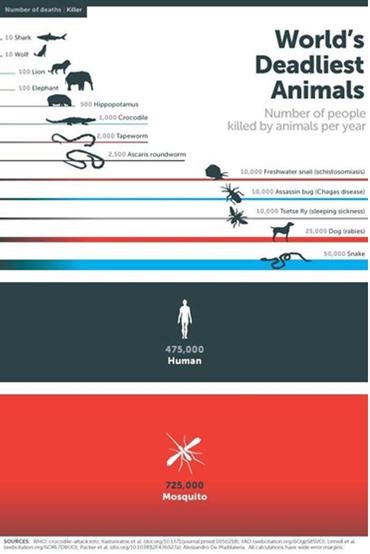 Mosquito Borne Diseases Malaria: Malaria is a mosquito-borne disease caused by a parasite. People with malaria often experience fever, chills, and flu-like illness. Left untreated, they may develop severe complications and die. In 2010 an estimated 219 million cases of malaria occurred worldwide and 660,000 people died, most (91%) in the African Region. Where: check the CDC website Malaria Information by Country Table or the CDC Malaria Map Application. West Nile Virus: West Nile virus (WNV) is most commonly transmitted to humans by mosquitoes. You can reduce your risk of being infected with WNV by using insect repellent and wearing protective clothing to prevent mosquito bites. There are no medications to treat or vaccines to prevent WNV infection. Fortunately, most people infected with WNV will have no symptoms. About 1 in 5 people who are infected will develop a fever with other symptoms. Less than 1% of infected people develop a serious, sometimes fatal, neurologic illness. Where: Africa, Europe, the Middle East, west and central Asia, or North America. Dengue: Dengue is an illness caused by a virus that is spread through mosquito bites. Symptoms include fever, headache, nausea, vomiting, rash, and pain in the eyes, joints, and muscles. After you are bitten by an infected mosquito, symptoms can take up to 2 weeks to develop but usually end in a week. In severe cases, symptoms may include intense stomach pain, repeated vomiting, bleeding from the nose or gums, and death. Where: tropical and subtropical regions including parts of the Caribbean, Central and South America , Western Pacific Islands, Australia, Southeast Asia, and Africa. DOs:
Mosquito Borne Diseases Malaria: Malaria is a mosquito-borne disease caused by a parasite. People with malaria often experience fever, chills, and flu-like illness. Left untreated, they may develop severe complications and die. In 2010 an estimated 219 million cases of malaria occurred worldwide and 660,000 people died, most (91%) in the African Region. Where: check the CDC website Malaria Information by Country Table or the CDC Malaria Map Application. West Nile Virus: West Nile virus (WNV) is most commonly transmitted to humans by mosquitoes. You can reduce your risk of being infected with WNV by using insect repellent and wearing protective clothing to prevent mosquito bites. There are no medications to treat or vaccines to prevent WNV infection. Fortunately, most people infected with WNV will have no symptoms. About 1 in 5 people who are infected will develop a fever with other symptoms. Less than 1% of infected people develop a serious, sometimes fatal, neurologic illness. Where: Africa, Europe, the Middle East, west and central Asia, or North America. Dengue: Dengue is an illness caused by a virus that is spread through mosquito bites. Symptoms include fever, headache, nausea, vomiting, rash, and pain in the eyes, joints, and muscles. After you are bitten by an infected mosquito, symptoms can take up to 2 weeks to develop but usually end in a week. In severe cases, symptoms may include intense stomach pain, repeated vomiting, bleeding from the nose or gums, and death. Where: tropical and subtropical regions including parts of the Caribbean, Central and South America , Western Pacific Islands, Australia, Southeast Asia, and Africa. DOs:
- Be aware of peak exposure times and places. Exposure to insect bites may be reduced if travelers modify their patterns or locations of activity. Although mosquitoes may bite at any time of day, peak biting activity for vectors of some diseases (such as dengue and chikungunya) is during daylight hours. Vectors of other diseases (such as malaria) are most active in twilight periods (dawn and dusk) or in the evening after dark. Avoiding the outdoors or taking preventive actions (such as using repellent) during peak biting hours may reduce risk.
- Eliminate mosquito breeding areas by removing items that hold stagnant water. If elimination is not possible you can drill holes for drainage or cover items to prevent water accumulation.
- If traveling globally check the potential for mosquitos at the destination.
- Wear mosquito repellent (DEET, picaridin, permethrin, oil of lemon eucalyptus)
- Follow application and use instructions for the repellent. i.e. Permethrin is not to be applied directly on skin, only clothing.
- Use aerosol or pump sprays for treating skin and clothing. These products provide an even application.
- Use liquids, creams, lotions or sticks to more precisely apply the product to exposed skin.
- Wash DEET-covered skin with soap and water after outdoor activity.
DON’Ts:
- Apply repellent to your brow, eyes, lips or mouth, or over cuts, wounds or irritated skin.
- Over-apply repellent to the skin, or saturate clothing.
- Apply repellent to skin beneath clothing, or to skin that is not exposed.
- Apply more often than recommended on the repellent product label.
